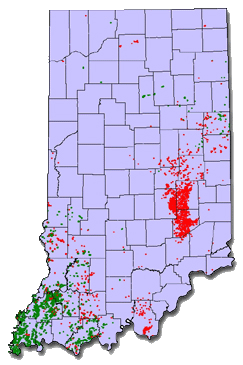
Map showing producing oil (green) and gas (red) wells in Indiana.
Oil and gas is produced from a number of fields located dominantly in the southwestern and east-central portions of the state. For maps showing the distribution of producing oil and gas fields in much of Indiana, see Oil, Gas, and Gas Storage Fields of Indiana.
Storage and Transportation of Natural Gas
Indiana has an extensive system of interstate and intrastate pipelines. These are high-pressure large-diameter steel pipes that are buried underground.Natural gas is also stored underground in Indiana in two basic forms: as liquefied petroleum gas (LPG) and as gas in storage fields. These reservoirs are filled in times of low demand (summer) and drawn down in times of peak demand (winter).
Geologic Information
There is a science devoted to the discovery of economic accumulations of oil and gas. A great deal of information about the geology and other characteristics of Indiana's oil and gas fields is available from the Indiana Geological Survey (keywords "oil" and "gas"). Reports about petroleum exploration, development, and production are published annually by the Indiana Geological and Water Survey (IGWS) as the Mineral Economic Series choose "Type" equal to "Mineral Economic Series"). Much of the data held by the IGWS is very specific, but other information is general in nature and can be used by a variety of concerned parties, including landowners, oil and gas professionals, and regulators. Contact the IGS Bookstore office of the IGWS (phone: 812-855-7636) for ordering or other information.
Additional information, including the current geometries of the individual fields and maps of counties (at a scale of 1:68,000) showing the location of individual wells, is available from the Subsurface Geology Section of the Indiana Geological Survey.
Exploration and Development
Oil and gas are explored for and developed by private corporations. There are many small companies within Indiana that conduct this type of work, many of which are based in the southwest portion of the state. Listings of such companies are available on the Operators Listing of the Indiana Department of Natural Resources, Division of Oil and Gas, and also from the Indiana Oil and Gas Association (phone: 812-432-8061). The latter is a trade organization that includes many operators working within the state.
Oil and Gas Leases

Pipelines (red), metropolitan areas (orange), and gas storage fields (black). IndianaMap allows interactive mapping of petroleum wells, oil and gas fields, and other features in Indiana.
Individual landowners typically negotiate a private agreement with an oil or gas company that is interested in exploring for and possibly producing petroleum on their property. These agreements are known as "oil or gas leases" and typically extend for a period of several years. Landowners are often compensated by receiving rental fees for the number of acres in the lease and a one-eighth royalty payment on the value of the oil or gas produced. Information about leases and leasing can be obtained from a variety of sources including the Extension Service of Purdue University , the American Association of Professional Landmen , and many oil and gas legal professionals. These groups and agencies are able to assist the concerned landowner in understanding their rights and opportunities relative to oil and gas exploration and production.
Regulation of Oil and Gas Operations
Exploration, drilling, production, and abandonment of oil and gas operations within the state are overseen principally by the Indiana Department of Natural Resources, Divison of Oil and Gas . Information about the acquisition of permits, the regulation of producing wells and associated facilities, and the plugging, abandonment, and restoration of well sites is also available from the Division.
The History of Gas and Oil Exploration
America’s first giant oil field was the Trenton Field of Indiana; gas was discovered there in 1876 in Delaware County. Beginning in 1886 and continuing into the first decade of the twentieth century, gas and then oil were discovered and developed in east-central Indiana. A wild unregulated boom ensued that ultimately resulted in thousands of wells being drilled. As gas and oil production declined in northern Indiana during the early 1900s, new discoveries were being made in the southwestern part of the state known as the Illinois Basin. Production reached a peak in 1956 at over 12 million barrels for the year, and has declined gradually since then. For a more detailed short history, see Oil and Gas in Indiana.
Problems with Oil Field Operations
To report a possible violation of the oil and gas law, a crude oil or saltwater spill, or water-well problem that might be related to oilfield operations, persons should contact the Indiana Department of Natural Resources, Division of Oil and Gas . For northern and central Indiana, contact Jim AmRhein at 317-232-6961; in southern Indiana, contact Kevin York at 812-853-8640.
Oil, Gas, and Ground Water
Brines from geologically deep levels can be introduced into shallow aquifers through corroded well casings. Leakage around oil-storage tanks and pipelines can also introduce oil contamination. The Indiana Department of Natural Resources, Division of Oil and Gas is charged with petroleum exploration, production and site abandonment activities, underground injection control, test hole drilling, and geophysical surveying operations.


